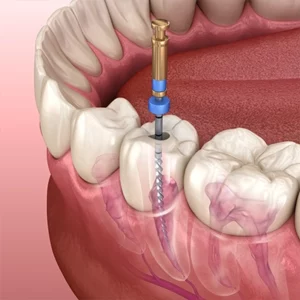
Root canal treatment is performed to salvage the structure of a natural tooth that is severely damaged or infected. For many years, this procedure has had a reputation for being painful. However, thanks to advancements in the dental industry and anesthesia options, it is much more comfortable and efficient.
Dr. Afroz Burges highly recommends root canal treatment in lieu of extraction to her patients. When possible, it’s best to save a natural tooth instead of having it removed and then going through the tooth replacement process.
Recovery begins as soon as the procedure is complete. The recovery phase is critical for the successful outcome of the procedure. This article explores what you need to know about root canal recovery.
Before we can explore root canal recovery, it’s important to have an understanding of the procedure. This procedure is often recommended when the dental pulp has gotten infected or damaged due to trauma or decay. The procedure involves drilling a small hole in the tooth to remove the infected/damaged pulp. Then, the inside of the tooth is thoroughly cleaned and disinfected before being filled and sealed to prevent further infection.
Root canal recovery time depends on several factors including the location of the tooth, the complexity of the procedure, and the severity of the damage/infection, as well as personal factors. Typically, recovery is divided into two phases: initial recovery and long-term recovery. Here’s what you need to know:
Immediately following the procedure, you will still have some residual numbness due to the local anesthesia. This typically wears off within a few hours. You should be cautious during this time to avoid biting your lips, cheeks, or tongue.
The initial recovery takes about a week or so, depending on your body’s ability to heal and the extent of the procedure. Here’s what you can expect during the initial recovery phase:
The intensity and duration of post-procedure pain varies from one patient to another- but most can expect to experience some mild pain and discomfort following root canal treatment. However, this can usually be managed with an OTC pain reliever. If the pain is severe for more than a few days, you should let your dentist know.
Swelling and bruising near the treated tooth are common, especially if the infection is severe and there is an abscess. You can use an ice pack in 15 to 20-minute increments during the first 24 hours.

Avoid eating or drinking immediately following root canal treatment until the numbness from the anesthesia has worn off. Once you are able to comfortably open your mouth, you should stick with soft, mild/bland foods. Additionally, stick with room-temperature beverages, as you may have some sensitivity. You can slowly transition back to your normal diet over the next few days.
Proper oral hygiene is critical during the recovery process to prevent the buildup of bacteria and reduce the risk of re-infection. However, be careful around the treated tooth to avoid causing irritation. You may want to use a saltwater rinse or medicated mouthwash to keep the area clean.
You will have one or more follow-up appointments after your procedure. The dentist will examine your mouth, especially the treated tooth, to assess your progress, remove temporary fillings or crowns, and discuss the next steps to restore the tooth.
Long-term root canal recovery can take several weeks to several months and involves waiting for full healing and preparation for a permanent restoration.
Dr. Burges recommends that patients have a permanent crown placed on a tooth after root canal treatment to protect it from further damage and restore its strength and appearance. This is typically done after the initial healing phase. Impressions will be taken of the tooth and sent to the dental lab to fabricate a custom crown placement is a critical component of the long-term recovery process because it protects and supports the treated tooth. A crown looks and functions like a natural tooth, allowing you to bite and chew comfortably.
Some patients experience mild pain/sensitivity after the crown is placed. This should resolve on its own within a few days to a week. OTC pain relievers and sensitivity toothpaste can help.
Once the dental crown is in place, it is critical to maintain proper oral hygiene. Make sure to brush and floss daily and visit the dentist at least every 6 months. Proper oral care is necessary for the long-term success of the procedure.
Root canal recovery varies from one patient to another- but most can return to their normal activities within a few days. However, there may be some residual pain/discomfort and swelling/bruising during those first few days. Long-term recovery involves dental crown placement and continuing oral care to ensure the success of the procedure.
Dr. Burges has the experience and expertise necessary to manage your root canal treatment and recovery.